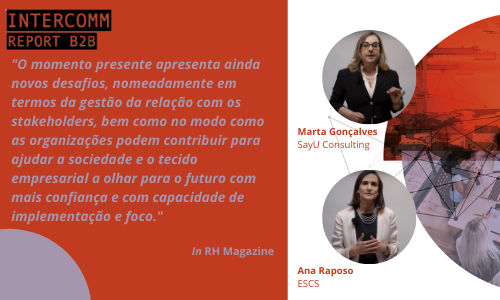
Communication as a priority for B2B companies
In Portugal, there are tens of thousands of companies whose activity is the starting point of the production and distribution chains, which sustain many of the big brands that we are used to living with every day as end consumers and which are totally unknown. Although the companies focused on business business-to-business (CRISIS) work on backstage of the value creation process, they are a key component of the national and international economy.
All companies, regardless of whether they focus on B2B or business-to-consumer (B2C), or more recently in D2C - direct-to-consumerwere surprised by a scenario that few, if any, of them had considered in their strategic planning. This event, classified by many as unexpected and by others as predictable but not considered, required many of them to redefine their routines and sometimes even rethink their purpose.
In this context, what is the role of communication in building and managing relationships with the public? stakeholders of Portuguese B2B companies with significant international business? And what are the ways to respond to the challenges these organizations may face today and in the future?
According to the InterComm Report - B2B Communication Trends in Global Businesses, when asked about the stakeholders with whom they communicate regularly, employees appear as the second most relevant - customers (95.1%), employees (81.4%), suppliers (79%), partners (77.4%). When asked if there are any plans to increase investment in communication with the aim of strengthening relations with stakeholdersOnce again, employees appear in the TOP 3 priorities.
Communication with employees has emerged during the pandemic as a reinforced priority for all organizations, regardless of their sector, business or size. At a time when we were hearing about automation and robotization and the challenges these realities brought to the job market, the SARS-CoV-2 pandemic put the issue of humanization on the table in a pressing way.
Faced with an unfamiliar context that required rapid adaptation, the priority was to ensure that the teams had all the conditions to carry out their duties, whether through teleworking or investment in personal protective equipment (PPE).
Once the health and safety of employees was taken care of, a new challenge quickly arose on the table: how to communicate with teams dispersed throughout space and who were learning to deal with a new normal, having to reconcile their professional, personal and family lives within four walls.
Looking back at what happened a year ago, the good practices shared by companies included active communication from the top of the organization, as a way of maintaining the trust levels of the teams. On the other hand, the creation of specific communication media which, depending on the characteristics and needs of each company, made it possible to share essential information to ensure business continuity, as well as content associated with the pandemic and the company's identity. New dynamics of events and interaction mediated by digital platforms and new offers from service providers that allow everyone to feel closer to each other. This was an important year to rethink and test new models of communication with employees.
The State of the Sector 2021, an international benchmark study over a decade old, which focuses on analyzing the challenges and trends in internal communication and employee engagement, reinforces some of the conclusions of the InterComm Report, namely the importance that employee engagement will have in the coming period. We will use the term EX - Employee ExperienceIt is also important to note that employee relationship management is a complex process influenced by different factors such as well-being, financial stability, the work environment, the technology used, leadership and culture, strategy and change management models, career progression and rewards and benefits. Considering the variables presented, the question that may arise is: Where does communication come into this equation?
Communication will be the aggregating element, and cannot just be understood as information, but as a process of creating relationships. If this function has been seen as a minor issue, it is now emerging as a function of growing importance, assuming a new priority position among the strategic thinking of many companies. Considered to be the "voice" of the brands, Internal Communication must be understood as an anchor to inspire trust with the different stakeholders. stakeholders.
The scenario in which we have been living for more than a year and which we are not sure when it will end, has made it clear that it is time for the top management of companies to understand what contribution communication can make to making companies more competitive. It is possible for a company to survive without communicating with its employees, but it will be more efficient if it intentionally and strategically manages the communication processes with those who make up the company and guarantee its activity.
In RH Magazine
